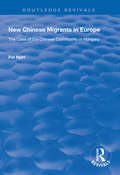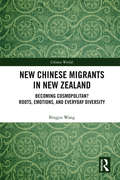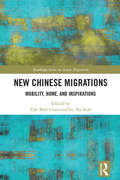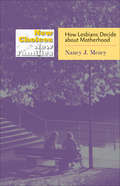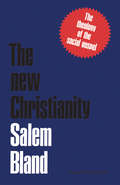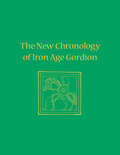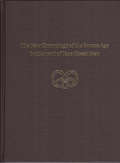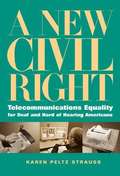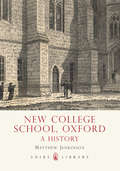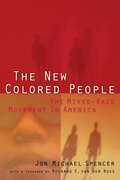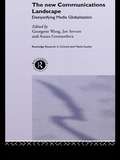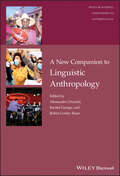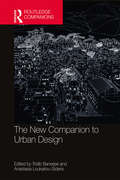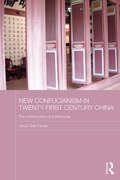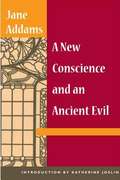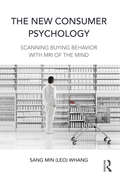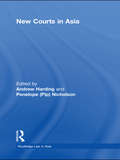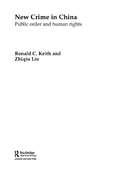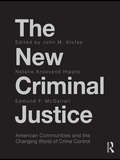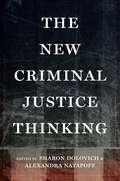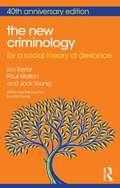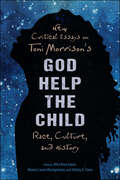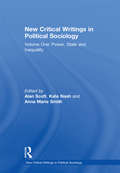- Table View
- List View
New Chinese Migrants in Europe: The Case of the Chinese Community in Hungary (Routledge Revivals)
by Pál NyíriFirst published in 1999, this book is a political enthnography of recent migration from the People’s Republic of China into Europe. It argues that the very high mobility and intensive communications of Chinese migrants enable them to maintain a transnational community within which they easily shift countries and social roles - from student to trader to worker - if doing so is economically expedient. This makes them the natural beneficiaries and users of the Western globalization discourse, even more so that - contrary to culturalist explanations of global Chinese networks - anonymity, sovereign decision making and freedom from social pressures are at least as important in motivating migration as family connections. Yet their identity discourse expresses an authentic Chinese globalization . Chinese migrants see themselves not as local minorities but as a global majority attached to China by a deterritorialised nationalism. This nationalism is not only encouraged by China’s official discourse but also supported by the economic dependence of new migrants on cultural capital built up in China, which makes them less reliant on resources in their countries of residence.
New Chinese Migrants in New Zealand: Becoming Cosmopolitan? Roots, Emotions, and Everyday Diversity (Chinese Worlds)
by Bingyu WangThere are growing waves of ‘desirable’ migrants from Asia moving to New Zealand, a place experiencing increasing ethnic diversity, particularly in its largest metropolitan region Auckland. In purely demographic terms much of this diversity has been generated by policy shifts since the 1980s and the adoption of a comparatively liberal immigration policy based on personal merit without discrimination on the grounds of race, national or ethnic origin. Due to these changes, migrants from China, and Asia more broadly, have become increasingly significant in migration flows into New Zealand. This in turn makes New Zealand a valuable case study for understanding how Chinese migrants integrate into and affect their host nation. Wang attempts to close a gap in contemporary research by relating cosmopolitanism to migration, particularly in the Asian context. With a cosmopolitan gaze towards migration studies, she makes four key contributions to the ongoing scholarly discussion. Firstly, this is the first comprehensive study to use cosmopolitanism as a framework to study the lives of contemporary Chinese migrants, with implications for migration studies as a whole. It sheds light on the relationship between cosmopolitanism and migrant mobility, taking a new approach to examine the living paradigms of international migrants. Secondly, this book identifies the emergence and development of cosmopolitanism outside the domain of Western middle-class groups. The concept of ‘rooted cosmopolitanism’ is utilised to break down the Eurocentric notion of cosmopolitanism, and to show the role played by Chinese rootedness during the process of becoming cosmopolitan and encountering diversity. Thirdly, the book advances and enriches the knowledge of studies in ‘everyday cosmopolitanism’, by focusing on ‘cosmopolitanism from below’, locating quotidian and ‘down-to-earth’ cosmopolitan engagements that are grounded in everyday migrant lives. Fourthly, it looks at the emotional dimension of migrants negotiating difference and engaging in cosmopolitanism, particularly the ways in which emotions undermine and promote the development of cosmopolitan sociability.
New Chinese Migrations: Mobility, Home, and Inspirations (Routledge Series on Asian Migration)
by Yuk Wah Chan Sin Yee KohWith the rapid economic development of China and the overall shift in the global political economy, there is now the emergence of new Chinese on the move. These new Chinese migrants and diasporas are pioneers in the establishment of multiple homes in new geographical locations, the development of new (global and hybrid) Chinese identities, and the creation of new (political, economic and social) inspirations through their mobile lives. This book identifies and examines new forms and paths of Chinese migration since the 1980s. It provides updated trends of migration movements of the Chinese, including their emergent geographies. With chapters highlighting the diversities and complexities of these new waves of Chinese migration, this volume offers novel insights to enrich our understanding of Asian mobility in the late 20th and early 21st centuries. The book will be of interest to academics examining migration, mobility, diaspora, Chinese identity, overseas Chinese studies and Asian diaspora studies.
New Choices, New Families: How Lesbians Decide about Motherhood
by Nancy J. MezeyHow do lesbians decide to become mothers or remain childfree? Why do new families form at particular historical moments? These questions are at the heart of Nancy J. Mezey’s New Choices, New Families. Researchers, politicians, and society at large continue to debate the changing American family, especially nontraditional families that emerge from divorce, remarriage, grandparents-as-parents, and adoption. This ongoing discussion also engages the controversy surrounding the parental rights of same-sex couples and their families. New Choices, New Families enters into this conversation. Mezey asks why lesbians are forming families at this particular historical moment and wonders how race, class, sexual identity, and family history factor into the decision-making process. Drawing heavily from personal interviews, Mezey’s groundbreaking analysis gives voice to groups long underrepresented in similar studies—black, Latina, working class, and childfree lesbians. Some chapters examine how childhood experiences contribute to the desire to become a mother, while others consider the influence of women’s partners and careers. New Choices, New Families provides thoughtful insights into questions about sexual identity, social and cultural expectations, and what and who constitute a family.
The New Christianity: The Theology of the Social Gospel
by Richard Allen Salem BlandThis volume, a survey of the Canadian scene that urged various reforms, appeared shortly after the First World War. It was considered to be extremely radical in its proposals and implications at that time and had the distinction of being one of that rare breed of attempts to survey Canadian developments in terms of large principles of analysis or historical development. In The New Christianity, Salem Bland tried to place the unrest of the times in a large historical perspective and brought social, political, and economic developments into conjunction with main trends of religion in recent decades. His central theme was that the processes of industrial and social consolidation, the growth of organized labour, and the spread of sociological ideas spelled the end of the old order of capitalism and Protestantism which had dominated most of western Christendom for three centuries. Specifically, the primary impediment to full realization of democracy and brotherhood, Bland argued, was modern capitalism based on private property rights in industry and motivated by a competitive individualism. The second impediment to a new social order embodying the Christian spirit was the strong attachment of Christians to their traditions. The chief hope of the future lay in a marriage of labour Christianity and American Christianity that would unite with all other traditions in a worldwide ecumenical movement.Fifty years later, the reprinting of this book is important because it is an instructive study in how the highest traditions of Christianity came into radical conjunction with the currents of economic change, social reform, and political upheaval in Canada in the first decades of this century.
The New Chronology of Iron Age Gordion
by C. Brian Rose Gareth DarbyshireThe New Chronology of Iron Age Gordion argues that the history and archaeology of the site of Gordion, in central Turkey, have been misunderstood since the beginning of its excavation in the 1950s. The first excavation director, Rodney Young, found evidence for substantial destruction during the first decade of fieldwork; this was interpreted as proof that Gordion had been destroyed ca. 700 B.C. by the Kimmerians, a group of invaders from the Caucusus/Black Sea region, as attested in several ancient literary sources. During the last decade, however, renewed research on the archaeological evidence, within, above, and below the destruction level indicated that the catastrophe that destroyed much of Gordion occurred 100 years earlier, in 800 B.C., and was the result of a fire that quickly got out of control rather than a foreign invasion.This discovery requires a reassessment of Anatolian history during the entire first millennium B.C. and has serious implications for our understanding of the surrounding regions, such as Assyria, Syria, Greece, and Urartu, among others. The New Chronology of Iron Age Gordion is the product of a multidisciplinary research program, with dendrochronology and radiocarbon dating working hand in hand with textual and artifact analysis, each of which is treated in a separate chapter in this volume. All of these categories of evidence point to the same conclusion and demonstrate that we need to look at Gordion, and much of the ancient Near East, in a completely new way.University Museum Monograph, 133
The New Chronology of the Bronze Age Settlement of Tepe Hissar, Iran
by Ayşe Gürsan-SalzmannTepe Hissar is a large Bronze Age site in northeastern Iran notable for its uninterrupted occupational history from the fifth to the second millennium B.C.E. The quantity and elaborateness of its excavated artifacts and funerary customs position the site prominently as a cultural bridge between Mesopotamia and Central Asia. To address questions of synchronic and diachronic nature relating to the changing levels of socioeconomic complexity in the region and across the greater Near East, chronological clarity is required. While Erich Schmidt's 1931-32 excavations for the Penn Museum established the historical framework at Tepe Hissar, it was Robert H. Dyson, Jr., and his team's follow-up work in 1976 that presented a stratigraphically clearer sequence for the site with associated radiocarbon dates. Until now, however, a full study of the site's ceramic assemblages has not been published.This monograph brings to final publication a stratigraphically based chronology for the Early Bronze Age settlement at Tepe Hissar. Based on a full study of the ceramic assemblages excavated from radiocarbon-dated occupational phases in 1976 by Dyson and his team, and linked to Schmidt's earlier ceramic sequence that was derived from a large corpus of grave contents, a new chronological framework for Tepe Hissar and its region is established. This clarified sequence provides ample evidence for the nature of the evolution and the abandonment of the site, and its chronological correlations on the northern Iranian plateau, situating it in time and space between Turkmenistan and Bactria on the one hand and Mesopotamia on the other.
A New Civil Right: Telecommunications Equality for Deaf and Hard of Hearing Americans
by Karen Peltz StraussKaren Peltz Strauss reveals how the paternalism of the hearing-oriented telecommunications industries slowed support for accessible technology for the deaf and hard of hearing users.
New College School, Oxford
by Matthew JenkinsonNew College School is one of the oldest continually functioning schools in the United Kingdom and, indeed, the world. It was founded in 1379 by William of Wykeham, Bishop of Winchester, to provide choristers for the chapel of New College, Oxford. Since then the School has had a peripatetic existence, occupying prime locations in the centre of a beautiful university city. Its pupils have witnessed centuries of dramatic history, including being inspected by Tudor monarchs during the Reformation and being forced out of their schoolroom during the English Civil War. The School has also grown over the centuries to include many more boys than those of the original choral foundation, educating and preparing them all for distinguished careers and fulfilled lives.
The New Colored People: The Mixed-Race Movement in America
by Jon M. SpencerWith a foreword by Richard E. Vander RossIn recent years, dramatic increases in racial intermarriage have given birth to a generation who refuse to be shoehorned into neat, pre-existing racial categories. Energized by a refusal to allow mixed-race people to be rendered invisible, this movement lobbies aggressively to have the category multiracial added to official racial classifications. While applauding the self-awareness and activism at the root of this movement, Jon Michael Spencer questions its ultimate usefulness, deeply concerned that it will unintentionally weaken minority power. Focusing specifically on mixed-race blacks, Spencer argues that the mixed-race movement in the United States would benefit from consideration of how multiracial categories have evolved in South Africa. Americans, he shows us, are deeply uninformed about the tragic consequences of the former white South African government's classification of mixed-race people as Coloured. Spencer maintains that a multiracial category in the U.S. could be equally tragic, not only for blacks but formultiracials themselves. Further, splintering people of color into such classifications of race and mixed race aggravates race relations among society's oppressed. A group that can attain some privilege through a multiracial identity is unlikely to identify with the lesser status group, blacks. It may be that the undoing of racial classification will come not by initiating a new classification, but by our increased recognition that there are millions of people who simply defy easy classification.
The New Communications Landscape: Demystifying Media Globalization (Routledge Research in Cultural and Media Studies #Vol. 7)
by Georgette Wang Jan Servaes Anura GoonasekeraThe innovative and rapid growth of communication satellites and computer mediated technologies in the late 1980s and early 1990s, combined with the deregulation of national broadcasting, led many media commentators to assume that the age of national media had been lost. But what has become clear is that, whilst there has been a limited growth in global media, there has been an emergence of a strong localised television and communications industry. Mapping the world media market, and using examples of programming from countries as diverse as Thailand, Hong Kong, Brazil, Taiwan, Spain and Britain, this volume explores theories of media globalization, examines the local culture of television programming and analyses the blurring of distinctions between the global and the local.
A New Companion to Linguistic Anthropology (Wiley Blackwell Companions to Anthropology)
by Alessandro Duranti Robin Conley Riner Rachel GeorgeProvides an expansive view of the full field of linguistic anthropology, featuring an all-new team of contributing authors representing diverse new perspectives A New Companion to Linguistic Anthropology provides a timely and authoritative overview of the field of study that explores how language influences society and culture. Bringing together more than 30 original essays by an interdisciplinary panel of renowned scholars and younger researchers, this comprehensive volume covers a uniquely wide range of both classic and contemporary topics as well as cutting-edge research methods and emerging areas of investigation. Building upon the success of its predecessor, the acclaimed Blackwell Companion to Linguistic Anthropology, this new edition reflects current trends and developments in research and theory. Entirely new chapters discuss topics such as the relationship between language and experiential phenomena, the use of research data to address social justice, racist language and raciolinguistics, postcolonial discourse, and the challenges and opportunities presented by social media, migration, and global neoliberalism. Innovative new research analyzes racialized language in World of Warcraft, the ethics of public health discourse in South Africa, the construction of religious doubt among Orthodox Jewish bloggers, hybrid forms of sociality in videoconferencing, and more. Presents fresh discussions of topics such as American Indian speech communities, creolization, language mixing, language socialization, deaf communities, endangered languages, and language of the law Addresses recent trends in linguistic anthropological research, including visual documentation, ancient scribes, secrecy, language and racialization, global hip hop, justice and health, and language and experience Utilizes ethnographic illustration to explore topics in the field of linguistic anthropology Includes a new introduction written by the editors and an up-to-date bibliography with over 2,000 entries A New Companion to Linguistic Anthropology is a must-have for researchers, scholars, and undergraduate and graduate students in linguistic anthropology, as well as an excellent text for those in related fields such as sociolinguistics, discourse studies, semiotics, sociology of language, communication studies, and language education.
The New Companion to Urban Design
by Tridib Banerjee Anastasia Loukaitou-SiderisThe New Companion to Urban Design continues the assemblage of rich and critical ideas about urban form and design that began with the Companion to Urban Design (Routledge, 2011). With chapters from a new set of contributors, this sequel offers a more comparative perspective representing multiple voices and perspectives from the Global South. The essays in this volume are organized in three parts: Part I: Comparative Urbanism; Part II: Challenges; and Part III: Opportunities. Each part contains distinct sections designed to address specific themes, and includes a list of annotated suggested further readings at the end of each chapter. Part I: Comparative Urbanism examines different variants of urbanism in the Global North and the Global South, produced by a new economic order characterized by the mobility of labor, capital, information, and technology. Part II: Challenges discusses some of the contemporary challenges that cities of the Global North and the Global South are facing and the possible role of urban design. This part discusses spatial claims and conflicts, challenges generated by urban informality, explosive growth or dramatic shrinkage of the urban settlement, gentrification and displacement, and mimesis, simulacra and lack of authenticity. Part III: Aspirations discusses some normative goals that urban design interventions aspire to bring about in cities of the Global North and the Global South. These include resilience and sustainability, health, conservation/restoration, justice, intelligence, access and mobility, and arts and culture. The New Companion to Urban Design is primarily intended for scholars and graduate students interested in cities and their built environment. It offers an invaluable and up-to-date guide to current thinking across a range of disciplines including urban design, planning, urban studies, and geography.
New Confucianism in Twenty-First Century China: The Construction of a Discourse (Routledge Contemporary China Series)
by Jesus Sole-FarrasThis book explores how Confucian thought, which was the ideological underpinning of traditional, imperial China, is being developed and refined into a New Confucianism relevant for the twenty-first century. It traces the development of Confucian thought, examines significant new texts, and shows how New Confucianism relates to various spheres of life, how it informs views on key philosophical issues, and how it affects personal conduct. Starting by exploring the philosophical and ideological principles of New Confucianism, the book goes on to explain how New Confucianism is a collective process of continuous creation and recreation, an incessant and evolving discourse. It argues that New Confucianism, unlike its earlier manifestation, is more accommodating of a plurality of ideologies in the world; and that understanding Confucianism and how it is developing is essential for understanding contemporary China.
A New Conscience and an Ancient Evil
by Jane AddamsPublished in 1912 on the heels of Twenty Years at Hull-House and at the height of Jane Addams's popularity, A New Conscience and an Ancient Evil assesses the vulnerability of the rural and immigrant working-class girls who moved to Chicago and fell prey to the sexual bartering of what was known as the white slave trade. Addams offers lurid accounts--drawn from the records of Chicago's Juvenile Protection Association--of young women coerced into lives of prostitution by men who lurked outside hotels and sweatshops. Because they lacked funds for proper recreation, Addams argues, poor and socially marginalized women were susceptible to sexual slavery, and without radical social change they would perhaps be "almost as free" as young men. In addition to promoting higher wages and better living conditions, Addams suggests that a longer period of public education for young women would deter them from the dangers of city life. Despite its appeal to middle-class readers eager for tales of sexual excess and the rape of innocence, the press and prominent intellectuals criticized A New Conscience and an Ancient Evil for being disproportionately hysterical to its philosophical weight. Katherine Joslin's introduction considers the controversial reactions to the book and the circumstances of its publication. Behind the sensationalism of the narratives, Joslin locates themes including the commodification of sex and the importance of marriage for young women.
New Conservatives in Russia and East Central Europe (Routledge Contemporary Russia and Eastern Europe Series)
by Katharina Bluhm Mihai VargaThis book explores the emergence, and in Poland, Hungary, and Russia the coming to power, of politicians and political parties rejecting the consensus around market reforms, democratization, and rule of law that has characterized moves toward an "open society" from the 1990s. It discusses how over the last decade these political actors, together with various think tanks, intellectual circles, and religious actors, have increasingly presented themselves as "conservatives," and outlines how these actors are developing a new local brand of conservatism as a full-fledged ideology that counters the perceived liberal overemphasis on individual rights and freedom, and differs from the ideology of the established, present-day conservative parties of Western Europe. Overall, the book argues that the "renaissance of conservatism" in these countries represents variations on a new, illiberal conservatism that aims to re-establish a strong state sovereignty defining and pursuing a national path of development.
The New Consumer Psychology: Scanning buying behavior with MRI of the mind
by Sang Min WhangThe term ‘consumption’ is generally thought of as process by which individuals purchase goods and services. The New Consumer Psychology attempts to explain consumption as a social behavior that satisfies individual values and desires. In modern society, individual needs are no longer determined solely by age or gender, but by the life values and desires that one pursues. This book uncovers people's subjective experiences of consumption in the capitalist society with interesting inside stories ranging from politics to designer handbags. <P><P>The book also provides valuable consumer insights into business and individuals by going beyond the limitations of population statistics and demonstrates Q-methodology is used to analyse consumers’ subjective responses. This book is an interesting take on how we should shift our focus from products to people and explains why identification and interpretations of different consumer groups are important in smart targeting. Its content will definitely inspire marketing strategies and market effectiveness.
New Contributions to the Philosophy of History
by Daniel LittleInsights developed in the past two decades by philosophers of the social sciences can serve to enrich the challenging intellectual tasks of conceptualizing, investigating, and representing the human past. Likewise, intimate engagement with the writings of historians can deepen philosophers' understanding of the task of knowing the past. This volume brings these perspectives together and considers fundamental questions, such as: What is historical causation? What is a large historical structure? How can we best conceptualize "mentalities" and "identities"? What is involved in understanding the subjectivity of historical actors? What is involved in arriving at an economic history of a large region? How are actions and outcomes related? The arguments touch upon a wide range of historical topics -- the Chinese and French Revolutions, the extension of railroads in the nineteenth century, and the development of agriculture in medieval China.
New Courts in Asia (Routledge Law in Asia)
by Andrew HardingThis book discusses court-oriented legal reforms across Asia with a focus on the creation of ‘new courts’ over the last 20 years. Contributors discuss how to judge new courts and examine whether the many new courts introduced over this period in Asia have succeeded or failed. The ‘new courts’ under scrutiny are mainly specialist courts, including those established to hear cases involving intellectual property disputes, bankruptcy petitions, commercial contracts, public law adjudication, personal law issues and industrial disputes. The justification of the trend to ‘judicialize’ disputes has seen the invocation of Western-style rule of law as necessary for the development of the market economy, democratization, good governance and the upholding of human rights. This book also includes critics of court building who allege that it serves a Western agenda rather than serving local interests, and that the emphasis on judicialization marginalises alternative local and traditional modes of dispute resolution. Adopting an explicitly comparative perspective, and contrasting the experiences of important Asian states - China, Japan, Korea, Malaysia, Vietnam, Brunei, Thailand and Indonesia - this book considers critical questions including: Why has the ‘new-court model’ been adopted, and why do international development agencies and nation-states tend to favour it? What difficulties have the new courts encountered? How have the new courts performed? What are the broader implications of the trend towards the adoption of judicial solutions to economic, social and political problems? Written by world authorities on court development in Asia, this book will not only be of interest to legal scholars and practitioners, but also to development specialists, economists and political scientists.
New Crime in China: Public Order and Human Rights (Routledge Contemporary China Series #Vol. 5)
by Ronald Keith Zhiqiu LinExamining the crimes that have recently been of the greatest concern in China, the authors assess the imbalance between public order and human rights in the way the Chinese legal system deals with crime. The issue of crime is of particular importance, both because current social upheaval in China has greatly contributed to the increase of new crimes, and because there is increasing international interest in Chinese law following the country’s accession to the World Trade Organization. This is an in-depth study on contemporary Chinese law reform, presenting a fascinating portrait of a society and legal system grappling with vast social change.
The New Criminal Justice: American Communities and the Changing World of Crime Control
by John Klofas Natalie Kroovand Hipple Edmund McGarrellCriminal Justice in the United States is in the midst of momentous changes: an era of low crime rates not seen since the 1960s, and a variety of budget crunches also exerting profound impacts on the system. This is the first book available to chronicle these changes and suggest a new, emerging model to the Criminal Justice system, emphasizing: collaboration across agencies previously viewed as relatively autonomous a focus on location problems and local solutions rather than a widely shared understanding of crime or broad application of similar interventions a deep commitment to research which guides problem assessment and policy formulation and intervention. Ideal for use in graduate, as well as undergraduate capstone courses.
The New Criminal Justice Thinking
by Sharon Dolovich Alexandra NatapoffA vital collection for reforming criminal justiceAfter five decades of punitive expansion, the entire U.S. criminal justice system— mass incarceration, the War on Drugs, police practices, the treatment of juveniles and the mentally ill, glaring racial disparity, the death penalty and more — faces challenging questions. What exactly is criminal justice? How much of it is a system of law and how much is a collection of situational social practices? What roles do the Constitution and the Supreme Court play? How do race and gender shape outcomes? How does change happen, and what changes or adaptations should be pursued? The New Criminal Justice Thinking addresses the challenges of this historic moment by asking essential theoretical and practical questions about how the criminal system operates. In this thorough and thoughtful volume, scholars from across the disciplines of legal theory, sociology, criminology, Critical Race Theory, and organizational theory offer crucial insights into how the criminal system works in both theory and practice. By engaging both classic issues and new understandings, this volume offers a comprehensive framework for thinking about the modern justice system. For those interested in criminal law and justice, The New Criminal Justice Thinking offers a profound discussion of the complexities of our deeply flawed criminal justice system, complexities that neither legal theory nor social science can answer alone.
The New Criminology: For a Social Theory of Deviance
by Ian Taylor Jock Young Paul Walton"The New Criminology was written at a particular time and place; it was a product of 1968 and its aftermath: a world turned upside down .It was a time of great changes in personal politics and a surge of politics on the left: Marxism, Anarchism, Situationism as well as radical social democratic ideas became centre stage." Jock Young, from the new introduction.Taylor, Walton and Young’s The New Criminology is one of the seminal texts in Criminology. First published in 1973, it marked a watershed moment in the development of critical criminological theory and is as relevant today as it was forty years ago. It was one of the first texts to bridge the gap between criminological and sociological theory and demonstrated the weaknesses of classical and positivist criminology. Critics at the time saw it as the first truly comprehensive critique of Anglo-American studies of crime and deviance.Reproduced unabridged, the fortieth anniversary edition includes a brand new introductory essay from Jock Young placing the book in its intellectual context and sequence and looking at the theories which built up to it and the theories that have been built upon since. It is essential reading for all serious students engaged in criminological theory and is destined to inspire future generations.
New Critical Essays on Toni Morrison's God Help the Child: Race, Culture, and History
by Alice Knox Eaton, Maxine Lavon Montgomery, and Shirley A. StaveContributions by Alice Knox Eaton, Mar Gallego, Maxine Lavon Montgomery, Evelyn Jaffe Schreiber, Shirley A. Stave, Justine Tally, Susana Vega-González, and Anissa Wardi In her eleventh novel, God Help the Child, Toni Morrison returned to several of the signature themes explored in her previous work: pernicious beauty standards for women, particularly African American women; mother-child relationships; racism and colorism; and child sexual abuse. God Help the Child, published in 2015, is set in the contemporary period, unlike all of her previous novels. The contemporary setting is ultimately incidental to the project of the novel, however; as with Morrison’s other work, the story takes on mythic qualities, and the larger-than-life themes lend themselves to allegorical and symbolic readings that resonate in light of both contemporary and historical issues. New Critical Essays on Toni Morrison's “God Help the Child”: Race, Culture, and History, a collection of eight essays by both seasoned Morrison scholars as well as new and rising scholars, takes on the novel in a nuanced and insightful analysis, interpreting it in relation to Morrison’s earlier work as well as locating it within ongoing debates in literary and other academic disciplines engaged with African American literature. The volume is divided into three sections. The first focuses on trauma—both the pain and suffering caused by neglect and abuse, as well as healing and understanding. The second section considers narrative choices, concentrating on experimentation and reader engagement. The third section turns a comparative eye to Morrison's fictional canon, from her debut work of fiction, The Bluest Eye, until the present. These essays build on previous studies of Morrison’s novels and deepen readers’ understanding of both her last novel and her larger literary output.
New Critical Writings in Political Sociology: Volume One: Power, State and Inequality (New Critical Writings in Political Sociology)
by Kate NashThe first volume of the series covers the key themes of political sociology as these have emerged in the course of the (sub-)discipline's development: state formation; legitimation; power; regulation, and inequality. The widening of the focus of political sociology from the nation-state and from models of power based on agents' wills and explicit agendas is reflected in the selection. The volume includes both 'standard' and highly-influential contributions - such as Elias on violence, Habermas on legitimation crisis or Lukes on power - and works that are perhaps less well known, but which represent a representative cross-section of themes and debates in the area. The historical formation of the state and its shifting spatial reach are covered in the first and final sections respectively. In between, both substantial issues - e.g. the changing nature of social policy and welfare regimes - and a wide range of theoretical and conceptual issues - are discussed by leading representative of the vying positions within the field.
